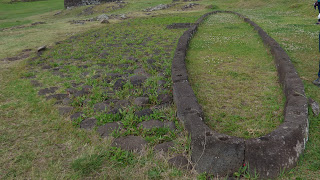We then went to the harbour. The guide put some breadcrumbs in the water, and in no time, the water was teeming wint small fish fighting over the crumbs
As it was Sunday, everyone was at the church for mass. You've all heard recordings of Pacific Islanders at church, and this was just the same. The church was full, and we we entered, and were made part of the service. It was great!
We expolred the town some more. All weekend the soccer field was being used for games.
We started to visit the statues. The first one was by itself away from the coast. Every single Maoi on Easter Island was toppled, so all the standing Moai have been rebuilt. This one shows the way they were created. The Maoi is on a stone plinth, with a second platform spreading out a bit lower, with rocks evenly spaced throughout the platform. Next there is a third platform that is just grass, but again, it can't be stood upon by normal people.
Behind the Moai, there is a grave where the original person's body is buried. The spirit from the body has inhabited the Moai.
At this site there were also two other artifacts. The first is a basin made from stone that has been carved out so water can be collected. As the stone is scoria, this was probably originally the hat for the Moai - after the Moai were toppled many of the hats were repurposed. The island has no running water so it was very important to the inhabitants to collect water where ever they could. The second is a cooking pit where they buried food and made fire with coals on top of the pit.
Then we visited the quarry for the hats for the Moai. Originally they all had hats, but most now don't. The hats were all of scoria, and so came from a different quarry to the Moai themselves, which were mainly of a different rock (although some were of scoria too). The hats were all lying around where they had ended up. as they were cylinders and of scoria, they were much easier to move than the Maoi themselves. As the Moai making progressed, different hairstyles for the hats were used.
Some of them had petroglyphs on them that were added when the birdman cult was being followed (after the Moai).
The first people to come to Easter Island were a group of seven explorers who were trying to find more islands for the Polynesians to inhabit. One of the sailors had dreamed of the island, and they all came here. One died while they were exploring, but the rest went back and brought the original settlers back with them. As a result these seven explorers were very important, and they were all celebrated with Moai.
After this, we went back to a site near the museum, where there were three separate platforms of Moai, and a number of buildings. The boat shape is the foundation for a grass and pole building where a family lived. The entrance is in the middle on the stone platform side.
Later, they started to build circular buildings to live in, and they also made circular chicken coupes. You can see the difference because the chicken coupes are much lower. As they were made of stone, the birds sheltered in them overnight but never laid their eggs in the coupes.
There is one complete Moai in this location (the only complete Moai I saw) - it has a hat and its eyes are in place - coral for the whites and obsidian for the iris.
This was a very important site, and there was a ceremonial boat ramp between the group of Moai and the first individual Moai.
And lastly, this is where I'm staying




















No comments:
Post a Comment